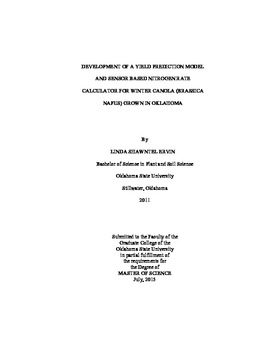| dc.contributor.advisor | Arnall, Brian | |
| dc.contributor.author | Ervin, Linda Shawntel | |
| dc.date.accessioned | 2016-09-29T18:40:02Z | |
| dc.date.available | 2016-09-29T18:40:02Z | |
| dc.date.issued | 2015-07-01 | |
| dc.identifier.uri | https://hdl.handle.net/11244/45254 | |
| dc.description.abstract | As the area under winter canola (Brassica napus) production increase and producers gain more experience with the crop many want to improve their nitrogen management practices. Oklahoma State University research and extension personnel have been developing and promoting the use of N-Rich strips and sensor based nitrogen rate calculator (SBNRC) in winter wheat since the late 90s. This study was conducted to determine if final grain yield of canola can be predicted with the use of normalized difference vegetative index (NDVI) and incorporate the yield prediction into a nitrogen fertilization optimization algorithm (NFOA) which would be used for an online SBNRC. In the fall of 2013 and 2014 trials were established at three locations. Trials consisted of twelve treatments in a RCBD with three replications in 2013 and 6 replications in 2014. Treatments 1-7 included a range of pre-plant N rates, these treatments were used to develop the yield prediction model. Treatments 8-12 consisted of a range of top-dress N rates, these treatments were used to validate the algorithms being developed. In 2013-2014 growing season, no data was able to be collected due to complete crop failure. In 2015, all data was combined and showed a high correlation between final grain yield and NDVI. When the data was narrowed to only sensor readings taken after growing degree days (GDD) reached 90, the relationship improved. Unlike previous algorithms developed, normalizing data with GDD or heat units did not improve upon the model. A low correlation was found between RIHARVEST and RINDVI which allowed the use of a RIADJUSTED value to be used in the NFOA. Utilization of the YP0 model and RIADJUSTED along with percent grain N (3.76%) and a NUE of 70%, the NFOA was developed. Using NFOA, top-dress N rates were calculated for both locaitons. The resulting recommendations were within 0 and 2 kg N ha-1 of the optimum N rate documented by the curve developed from the top-dress treatments. While much more work is needed this work documents that the use NDVI measurement and the N-Rich strip utilized in a yield prediction and RI model can be used to produce an accurate top-dress N rate. | |
| dc.format | application/pdf | |
| dc.language | en_US | |
| dc.rights | Copyright is held by the author who has granted the Oklahoma State University Library the non-exclusive right to share this material in its institutional repository. Contact Digital Library Services at lib-dls@okstate.edu or 405-744-9161 for the permission policy on the use, reproduction or distribution of this material. | |
| dc.title | Development of a Yield Prediction Model and Sensor Based Nitrogen Rate Calculator for Winter Canola Grown in Oklahoma | |
| dc.type | text | |
| dc.contributor.committeeMember | Warren, Jason | |
| dc.contributor.committeeMember | Raun, William Robert | |
| osu.filename | Ervin_okstate_0664M_14178.pdf | |
| osu.accesstype | Open Access | |
| dc.description.department | Plant & Soil Sciences | |
| dc.type.genre | Thesis | |
